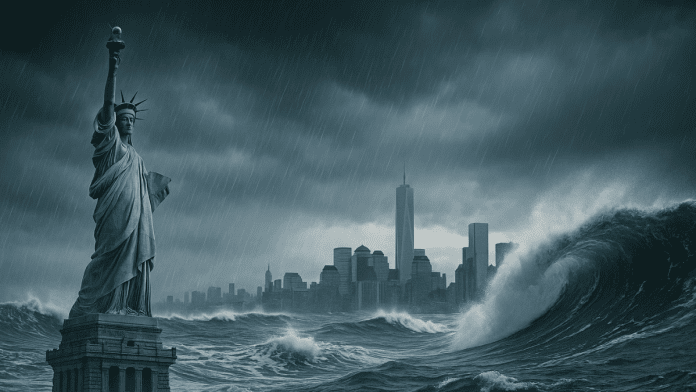🕒 Last updated on July 16, 2025
A new scientific report has raised alarm bells for many Northern U.S. cities, especially New York. According to the research, insured losses from hurricanes in New York could rise by more than 60% if the planet continues to warm.
Northern Cities Face New Storm Threat
The research looked at a climate scenario where the global temperature rises 2°C above pre-industrial levels—a level many experts say we’re heading toward. In this warmer world, New York would experience far more powerful and frequent hurricanes than today, leading to higher damage and insurance claims.
The research was done using advanced storm models. Scientists used a climate dataset that simulates what hurricanes could look like in a 2°C warmer climate. Then, they ran 100,000 years’ worth of virtual hurricane events to understand how damage and insured losses would change.
Florida will still face the highest total insured losses because it already sees more hurricanes. But when comparing how much the losses would increase, New York stands out. A 64% increase in insured hurricane losses was seen in the models. This big jump is due to more storms reaching farther north and staying strong for longer. Warmer ocean water helps these storms stay intense even as they move away from the usual hurricane zones.
This new data shows how climate change is reshaping the storm risk map in the U.S., putting places like New York, Rhode Island, and Massachusetts in a much more dangerous position.
States Like Rhode Island and Massachusetts See Bigger Increases
While New York’s increase is alarming, Rhode Island and Massachusetts may see even larger jumps in average annual insured losses. The report says these two states could see their hurricane insurance losses rise by more than 70%.
Massachusetts is particularly striking. Under today’s climate, it’s ranked eighth in terms of hurricane losses. But in the warmer climate model, it jumps up to seventh place, thanks to a 71% surge in projected losses.
These states usually don’t see many strong hurricanes. That’s part of the problem. Because hurricanes used to weaken before reaching the Northeast, people and buildings in those areas weren’t built with strong storms in mind. But now, scientists say that warmer oceans allow hurricanes to keep their strength and hit Northern cities harder.
NBFC Panic Grows: Visa Clampdown in US, Canada Sparks ₹20,000 Cr Student Loan Crisis
The report makes one thing very clear: the effects of climate change are not the same everywhere. Some states like the Carolinas are expected to be hit much harder during storm years. In fact, the 1-in-5-year loss—a big storm event—could double in the Carolinas. That’s a 100% increase, compared to 40% in Texas and just over 40% nationwide.
Even more concerning, the number of years without any landfall from hurricanes is expected to drop by 30%. That means hurricanes will strike more often, even in areas not used to them.
Insurance Costs, Market Gaps, and Underprepared Cities
The increase in storm risk is not just a problem for scientists. It could lead to real financial troubles for cities and homeowners. The report warns that insurance companies are not keeping up with the pace of climate change. The risk is going up, but insurance pricing and coverage terms are not matching that risk.
That creates a serious gap between what is insured and what is actually at risk. If this gap continues to grow, families and communities might not have enough coverage when a big storm hits.
Another major concern is that building codes and storm safety rules in places like New York and Massachusetts are not as strict as those in Gulf Coast states like Florida. But with more strong hurricanes coming north, the report says those codes should be updated to reduce the damage in the future.
The research also shows that the impact of climate change on insurance is not the same for everyone. Regional insurance companies might see very different losses compared to national insurance providers. Such variations could cause big changes in the way insurance is offered and priced in different parts of the country.
Lastly, while this study focused only on insured hurricane losses, it did not include extra damage from rising sea levels, more intense rainfall, or the growing number of people moving into high-risk areas. That means the real financial damage could be even higher than the study shows.
As more storms hit the Northeast and other unexpected regions, the pressure on insurance companies, city planners, and homeowners will only grow. The report says this is not just about numbers—it’s about being ready for a new storm reality that is quickly approaching.

